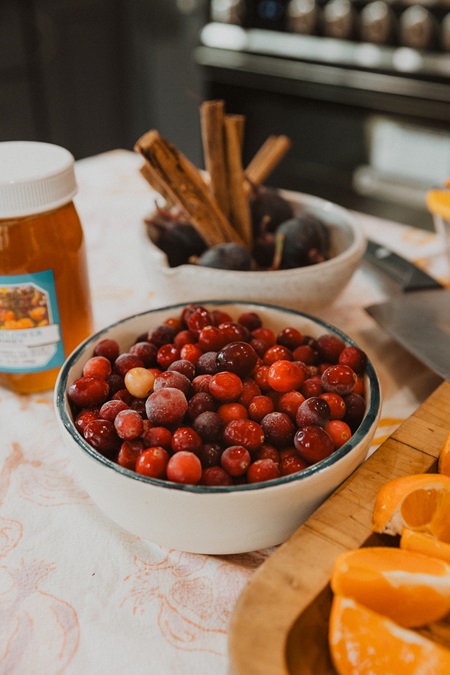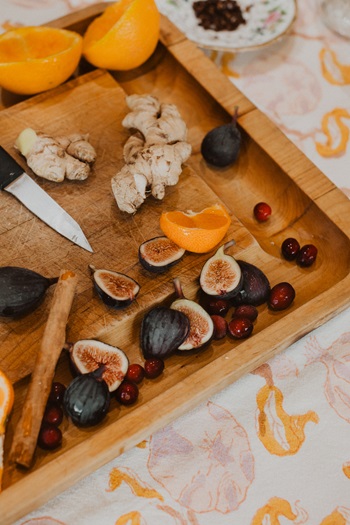Sheila Shupe Makes Honey Fermented Cranberries
Photos by Tammy Horton
Thanksgiving is my favorite holiday, hands down. No presents to fret over, no costumes with weird facepaint to wash off, no fights over how many jelly beans a rational human should consume in one sitting. Just family. And food. And my love affair with the morning-after Thanksgiving sandwich. I go all the way with mine. I warm up the mashers and stuffing and turkey, then load it onto a roll with mayo and mustard, and, of course, the magic ingredient that crowns the quintessential ‘merican Thanksgiving sandwich: the cranberry sauce.
The past few years, my sister-in-law Erika and I have had a silent cranberry duel. I make some kind of avant garde cranberry sauce with nuts and carrots in it, or I find a locally sourced version of said condiment, replete with rosemary sprigs tied to the lid with twine and a handwritten note showing the love and care that went into a project. Then I look over, and out of nowhere, the wobbly cylinder of crangelatinous goo, scarred by the imprints of the can it just slid out of, is sitting on a plate in the middle of my table! Eyes downcast, she SLICES chunks off the atrocity while I generously and repeatedly offer her my version to try. I get it. Those childhood memories have a powerful grip on our neural nets. But this year, I just know that woman is going to skip the jelly tube and swerve my way.
This year, I’m bringing germs to the party with these honey fermented cranberries—no one will be able to resist (not even you, Erika). This is one of the easiest ferments I have shared in this magazine, and it’s worth its weight in gold. Aside from the perfect addition to your brined, deep fried, smoked or good-old-fashioned roast turkey, it would be amazing over some goat cheese with crackers, spooned over a pork cutlet, or you can drizzle the infused honey over your best spice cake. I’m telling you, this winter wonder could carry you through every party until Christmas.
This is my first fermentation with honey, and every time I research this magical golden liquid, I find more to love. Did you know honey is antimicrobial? Apparently, this is so the bees can keep their hive healthy. It’s also why it’s good to swallow a spoonful when you have a sore throat, or to use in cough syrups or medicinal infusions. In my research for this recipe, I found out that despite the fact that honey is antibacterial, you can also use it to culture food! When water or vegetable matter is added to honey, it prevents the growth of harmful bacteria and makes good bacteria flourish.
Honey also contains amylase, an enzyme that helps us break down complex carbohydrates so they can be absorbed more easily by the body. This is why I feel good giving it to my girls on toast or in their oatmeal. It also contains protein and prebiotics, the food our good gut bacteria need to thrive. It seriously is my favorite sweetener. Keep in mind, fermenting with honey requires that it be raw.
On top of our golden bee-made wonder, this recipe delivers the benefits of probiotics from the ferment, vitamin C from the orange zest and cranberries, and a soothing tummy vibe from the ginger. Cranberries also increase the acid in your blood, making them highly effective in healing kidney and bladder ailments.
You should definitely plan to get this stuff on your Thanksgiving table, but don’t stop there. It would make an epic baked chicken dish, a great dessert warmed over ice cream, and you can strain off the honey and use it in teas, fruit drinks, cocktails, salad dressings, or even your winter batch of fire cider! It’s a cran-tacular, germtastic secret weapon, for those of us brave enough to go head-to-head with the old guard on Turkey Day. Erika, get ready, ‘cuz your can is no match for my cran.
As always, tweak as you like to get the flavors you want. Eliminate or add spices or fruit—raisins, figs and onions were popular online, but I could see pineapple or carrots being great in here, too. Just remember, you need to make it at least two weeks in advance, and the longer it sits, the better it gets. Whatever you do, make it yours, make it great, and think of me when you bite into that heavenly turkey sandwich on Friday.
Honey Fermented Cranberries
Materials
one quart glass jar
paper towel, coffee filter, or airlock lid for fermentation
one ziplock bag
one rolling pin or wine bottle
INGREDIENTS
1.25 cups fresh or frozen cranberries
one orange
one knuckle of ginger
one stick of cinnamon
one cup of local, organic, raw honey
INSTRUCTIONS
- Zest the entire orange and add zest to jar.
- Juice the orange after zesting and add juice to the jar.
- Zest the knuckle of ginger and add to the jar.
- Put cranberries in a ziplock, seal tightly, and roll over it with the rolling pin. Make sure you hear all of them pop – this ensures that the good bacteria can reach the inside of the berries so they will ferment completely.
- Add cranberries to the jar.
- Cover with honey (there will be room).
- Cover the jar with a paper towel or coffee filter and a rubber band, or an airlock lid.
- Leave the jar in a cool dark place.
- Every day or so, be sure to stir the cranberries with a wooden spoon, or put a lid on and shake them up to coat. They will float to the top and the honey will become more runny.
- In about a week bubbles will start to form, which is how you know the ferment is happening.
- You can continue to ferment on the counter for up to six months, or you can taste after a week and once they are to your desired liking, you can put them in the fridge to slow the fermentation. (These are best after two weeks and only get better with time.)
- Be sure to open the jar every few days, or leave the lid slightly open to off gas the fermentation.
- When you are ready to serve, remove the cinnamon stick and serve as is or run it through your food processor to make a relish.
- Alternately, you can strain the cranberries and keep the honey to use in drinks and dressings.



